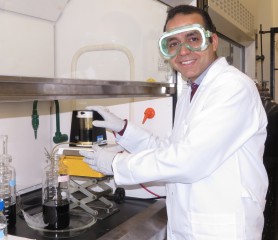Protecting Food Crops From Soil Contaminants

Mohamed Elsayed, a Fulbright Postdoctoral Scholar at South Dakota State University’s chemistry and biochemistry department, uses ultrafiltration techniques to break humic acid down into smaller molecules that can then combine with clay minerals in the soil to trap pollutants.
Using natural soil components to trap pollutants will allow producers to control soil contaminants and reuse draining water while protecting their agricultural crops, according to Mohamed Elsayed, a Fulbright Postdoctoral Scholar at South Dakota State University’s chemistry and biochemistry department.
Elsayed, a researcher from the Soil Water and Environmental Research Institute at the Agricultural Research Center in Egypt, will present his work at the American Chemical Society National Meeting March 22-26 in Denver.
If crops are sown in polluted soil, the plants absorb the contaminants, Elsayed explained. These are then transferred to humans when they consume the vegetables or grains.
Because of water shortages in Egypt, Elsayed said, “we need to use water again and again, but before we reuse it, we need to clean it.”
His research seeks to increase the ability of humic acid to adsorb or trap pollutants in combination with either of two clay minerals—kaolinite or montmorillonite. Humic acid is one of the major organic components in soil and is also used as fertilizer.
“The idea is to use natural materials to reduce the pollutants,” he explained. “Natural components are cheaper, more easily available.” Plus, artificial ingredients run the risk of adding to the pollution problems—natural ingredients don’t.
By breaking humic acid into smaller molecules, a process called fractionation, Elsayed hopes to improve the interaction between humic acid and clay minerals and, therefore, their ability to trap pollutants, particularly heavy metals. This project is a continuation of his doctoral research.
If fractionation produces good results, the next step will be to determine the optimum humic acid fractionation combination for each clay mineral to enhance the trapping process, Elsayed explained.
The long-range vision is for producers to apply humic acid, either in solid or liquid form, to enhance soil properties.
“These compounds would capture the heavy metals and organic pollutants so the plant won’t take it up,” he said. The resulting crop would be contaminant-free.
About South Dakota State University
Founded in 1881, South Dakota State University is the state’s Morrill Act land-grant institution as well as its largest, most comprehensive school of higher education. SDSU confers degrees from eight different colleges representing more than 175 majors, minors and specializations. The institution also offers 32 master’s degree programs, 15 Ph.D. and two professional programs. The work of the university is carried out on a residential campus in Brookings, at sites in Sioux Falls, Pierre and Rapid City, and through Cooperative Extension offices and Agricultural Experiment Station research sites across the state.
Contact Information
Christie Delfanian
Research Writer
christie.delfanian@sdstate.edu
Phone: 605-688-4541
Mobile: 605-651-4183
Mohamed.Elsayed@sdstate.edu
Media Contact
More Information:
http://www.sdstate.eduAll latest news from the category: Agricultural and Forestry Science
Newest articles

“Nanostitches” enable lighter and tougher composite materials
In research that may lead to next-generation airplanes and spacecraft, MIT engineers used carbon nanotubes to prevent cracking in multilayered composites. To save on fuel and reduce aircraft emissions, engineers…

Trash to treasure
Researchers turn metal waste into catalyst for hydrogen. Scientists have found a way to transform metal waste into a highly efficient catalyst to make hydrogen from water, a discovery that…

Real-time detection of infectious disease viruses
… by searching for molecular fingerprinting. A research team consisting of Professor Kyoung-Duck Park and Taeyoung Moon and Huitae Joo, PhD candidates, from the Department of Physics at Pohang University…





















